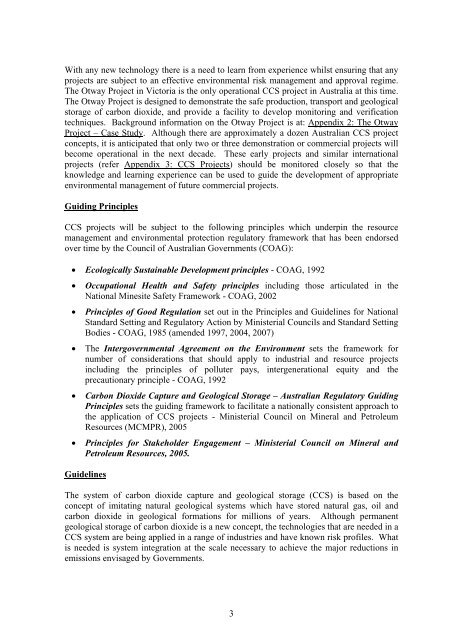Environmental Guidelines for Carbon Dioxide Capture and ...
Environmental Guidelines for Carbon Dioxide Capture and ...
Environmental Guidelines for Carbon Dioxide Capture and ...
Create successful ePaper yourself
Turn your PDF publications into a flip-book with our unique Google optimized e-Paper software.
With any new technology there is a need to learn from experience whilst ensuring that anyprojects are subject to an effective environmental risk management <strong>and</strong> approval regime.The Otway Project in Victoria is the only operational CCS project in Australia at this time.The Otway Project is designed to demonstrate the safe production, transport <strong>and</strong> geologicalstorage of carbon dioxide, <strong>and</strong> provide a facility to develop monitoring <strong>and</strong> verificationtechniques. Background in<strong>for</strong>mation on the Otway Project is at: Appendix 2: The OtwayProject – Case Study. Although there are approximately a dozen Australian CCS projectconcepts, it is anticipated that only two or three demonstration or commercial projects willbecome operational in the next decade. These early projects <strong>and</strong> similar internationalprojects (refer Appendix 3: CCS Projects) should be monitored closely so that theknowledge <strong>and</strong> learning experience can be used to guide the development of appropriateenvironmental management of future commercial projects.Guiding PrinciplesCCS projects will be subject to the following principles which underpin the resourcemanagement <strong>and</strong> environmental protection regulatory framework that has been endorsedover time by the Council of Australian Governments (COAG):• Ecologically Sustainable Development principles - COAG, 1992• Occupational Health <strong>and</strong> Safety principles including those articulated in theNational Minesite Safety Framework - COAG, 2002• Principles of Good Regulation set out in the Principles <strong>and</strong> <strong>Guidelines</strong> <strong>for</strong> NationalSt<strong>and</strong>ard Setting <strong>and</strong> Regulatory Action by Ministerial Councils <strong>and</strong> St<strong>and</strong>ard SettingBodies - COAG, 1985 (amended 1997, 2004, 2007)• The Intergovernmental Agreement on the Environment sets the framework <strong>for</strong>number of considerations that should apply to industrial <strong>and</strong> resource projectsincluding the principles of polluter pays, intergenerational equity <strong>and</strong> theprecautionary principle - COAG, 1992• <strong>Carbon</strong> <strong>Dioxide</strong> <strong>Capture</strong> <strong>and</strong> Geological Storage – Australian Regulatory GuidingPrinciples sets the guiding framework to facilitate a nationally consistent approach tothe application of CCS projects - Ministerial Council on Mineral <strong>and</strong> PetroleumResources (MCMPR), 2005• Principles <strong>for</strong> Stakeholder Engagement – Ministerial Council on Mineral <strong>and</strong>Petroleum Resources, 2005.<strong>Guidelines</strong>The system of carbon dioxide capture <strong>and</strong> geological storage (CCS) is based on theconcept of imitating natural geological systems which have stored natural gas, oil <strong>and</strong>carbon dioxide in geological <strong>for</strong>mations <strong>for</strong> millions of years. Although permanentgeological storage of carbon dioxide is a new concept, the technologies that are needed in aCCS system are being applied in a range of industries <strong>and</strong> have known risk profiles. Whatis needed is system integration at the scale necessary to achieve the major reductions inemissions envisaged by Governments.3
















